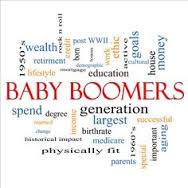Aging baby boomers – the demographic looms large – and their future is likely underserved. You see it everywhere, baby boomer-focused marketing, articles about their wealth and interests, etc. Yet the 30 million peak boomers also represent a bleak future ‘peak burden.’ This Economic Impact study published in April 2024 notes that two-thirds are not prepared for retirement. The details of this study are depressing – about a future that will be financially worse for women than men, in total representing 30 million people who will all be 65+ in six years. On the positive side, according to an AARP survey there is growing interest in technology from the older adult population, particularly in fitness apps. But are useful technologies viewed in combination for the baby boomers’ life and health span? Not yet. Here are the four blog posts from July, 2024:
The population is aging – and still, the tech solution market is immature. Investors of all types demonstrate interest in a product here and an offering there. Competitions highlight product winners; money is raised for one product at a time. One reason for the immaturity of the market is the behavior of buyers. Consumers and senior living companies buy a product for this and an offering for that. The future is predicted to incorporate new technology like AI – someday. Everyone agrees that AI could enhance retirement living and healthcare, but deployment of new offerings is always described as in the future. No other software categories in tech history – consider office, finance, supply chain – remained a laundry list of point products when markets expect suites. Read more.
Technology has enhanced the world for those with vision limitations. As many as 50 million Americans have some degree of vision loss — a problem that was poorly addressed by technology prior to the arrival of smartphone navigation, smart glasses, sensors, robotics and AI in nearly all devices and technologies. Today, it’s a whole new and innovative world — supportive of individuals with a range of vision limitations from low vision to completely blind. And in fact, today those who are blind can use haptics to follow a game in real time, even in a stadium. They can create presentations from data sets, read road signs down the road, navigate airports and safely make their way through obstacle-filled streets. Here are five technology enablers that will likely make a difference: Read more.
We are not suspicious enough to prevent scams. It’s a bad sign when you get a warning from Amazon about Prime scams. Shopping online has definitely deteriorated when you receive a desperate email from Amazon warning about Amazon Prime scams. But their advice is worrisome – you should check Amazon Messages to verify that a message is really from Amazon? How hard can it be for a scammer to fake messages that look like they’re from Amazon? Did you know that Amazon Prime Day is a big day for scammers? The Better Business Bureau warns about lookalike websites, too-good-to-be-true social media ads, and unsolicited emails or calls during sales events this month. You might not know that “1,230 new websites that associated themselves with Amazon popped up in June. The vast majority were malicious or appeared suspicious, according to Check Point.” Read more.
AARP’s new Survey makes the case for health and wellness suites. Their researchers fielded an online survey about the use of digital health that is worth a look. The topic was health and wellness app usage by the 50+ population. The goal was to understand 50+ level of engagement with health and wellness apps – an online survey that included 694 individuals who owned smartphone or tablet. Interestingly the 15-minutes survey also includes a response comparison with 40-49 year-olds, likely because that is ’s next-up target membership. Responders needed to be comfortable with downloading a health and wellness app — and have interest in trying them. Read more.
[Check out the latest report, The User Experience Needs An Upgrade May 2024]




